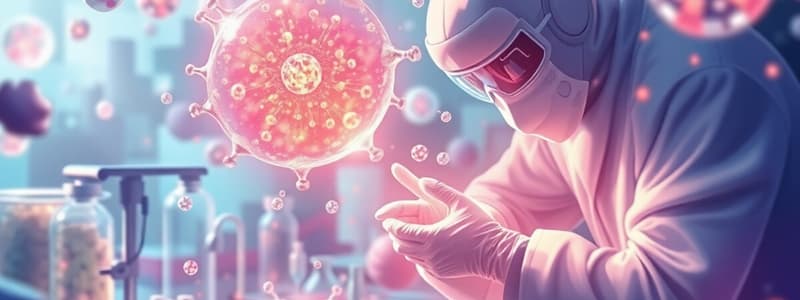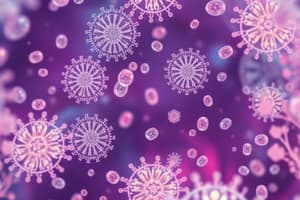Podcast
Questions and Answers
What is the primary characteristic of viruses affecting mammalian cell cultures?
What is the primary characteristic of viruses affecting mammalian cell cultures?
- They take over the host cell's machinery to reproduce. (correct)
- They reproduce independently in culture.
- They always cause visible changes to the host cells.
- They are larger than bacteria.
Which method is NOT commonly used to detect viral contamination in cell cultures?
Which method is NOT commonly used to detect viral contamination in cell cultures?
- PCR with appropriate viral primers
- Electron microscopy
- Culture on nutrient agar (correct)
- ELISA assays
What type of effect can some viruses have on infected cells that can be observed under a microscope?
What type of effect can some viruses have on infected cells that can be observed under a microscope?
- Cytopathic effect (correct)
- Increased motility of cells
- Color change in the medium
- Cell growth enhancement
What challenge do viruses pose in cell culture laboratories?
What challenge do viruses pose in cell culture laboratories?
What health risk can arise from using virally infected cell cultures?
What health risk can arise from using virally infected cell cultures?
What indicates a positive result for endotoxin in the LAL test?
What indicates a positive result for endotoxin in the LAL test?
Which of the following can be a source of endotoxin in cell culture?
Which of the following can be a source of endotoxin in cell culture?
What effect can endotoxin have on cell cultures?
What effect can endotoxin have on cell cultures?
Which type of contamination is particularly problematic due to its small size?
Which type of contamination is particularly problematic due to its small size?
What is the key approach to prevent contamination in mammalian cell cultures?
What is the key approach to prevent contamination in mammalian cell cultures?
What indicates that a mammalian cell culture needs replacing or sub-culturing?
What indicates that a mammalian cell culture needs replacing or sub-culturing?
What is the doubling time for mammalian cells?
What is the doubling time for mammalian cells?
Which characteristic is indicative of bacterial contamination in mammalian cell cultures?
Which characteristic is indicative of bacterial contamination in mammalian cell cultures?
How do yeast appear under a microscope when they contaminate a culture?
How do yeast appear under a microscope when they contaminate a culture?
What happens to the pH of a culture contaminated by mold in initial stages?
What happens to the pH of a culture contaminated by mold in initial stages?
What is a common result of heavy yeast contamination in a culture?
What is a common result of heavy yeast contamination in a culture?
Under microscopic evaluation, how do bacteria generally appear?
Under microscopic evaluation, how do bacteria generally appear?
What leads to the yellow color in the culture medium?
What leads to the yellow color in the culture medium?
What is the primary component of endotoxin in Gram-negative bacteria?
What is the primary component of endotoxin in Gram-negative bacteria?
Which method is NOT used to detect Mycoplasma contamination in cell cultures?
Which method is NOT used to detect Mycoplasma contamination in cell cultures?
What effect can endotoxin have on the host organism?
What effect can endotoxin have on the host organism?
What is a reliable method for avoiding cross-contamination in cell cultures?
What is a reliable method for avoiding cross-contamination in cell cultures?
What is a key feature of the Limulus amoebocyte lysate (LAL) assay?
What is a key feature of the Limulus amoebocyte lysate (LAL) assay?
Which method is NOT used for detecting cell line contamination?
Which method is NOT used for detecting cell line contamination?
How long does the microbiological broth-agar colony assay take before results are available?
How long does the microbiological broth-agar colony assay take before results are available?
What is the recommended action when faced with microbial contamination?
What is the recommended action when faced with microbial contamination?
Why is mycoplasma considered a troublesome contaminant in cell cultures?
Why is mycoplasma considered a troublesome contaminant in cell cultures?
What major issue does mycoplasma contamination cause in cell cultures?
What major issue does mycoplasma contamination cause in cell cultures?
What is the primary challenge in detecting mycoplasma contamination?
What is the primary challenge in detecting mycoplasma contamination?
Which of the following statements about viral contamination is true?
Which of the following statements about viral contamination is true?
What is the major reason for avoiding the treatment of cultures with antibiotics during contamination?
What is the major reason for avoiding the treatment of cultures with antibiotics during contamination?
What is the primary purpose of creating an aseptic environment in mammalian cell culture?
What is the primary purpose of creating an aseptic environment in mammalian cell culture?
Which of the following is NOT a source of biological contamination in mammalian cell cultures?
Which of the following is NOT a source of biological contamination in mammalian cell cultures?
What is a strong indicator of bacterial contamination in mammalian cell cultures?
What is a strong indicator of bacterial contamination in mammalian cell cultures?
Which of the following statements about phenol red is true?
Which of the following statements about phenol red is true?
Which contaminant is particularly noted as problematic in mammalian cell cultures?
Which contaminant is particularly noted as problematic in mammalian cell cultures?
What is the core aim of discussing contamination in mammalian cell cultures?
What is the core aim of discussing contamination in mammalian cell cultures?
In what form does contamination in cell cultures occur?
In what form does contamination in cell cultures occur?
Which of the following reflects the appearance of phenol red in media at a pH of 7.4?
Which of the following reflects the appearance of phenol red in media at a pH of 7.4?
What type of contamination could arise from cross-contamination in cell cultures?
What type of contamination could arise from cross-contamination in cell cultures?
Which of the following practices is essential to prevent contamination in mammalian cell cultures?
Which of the following practices is essential to prevent contamination in mammalian cell cultures?
Flashcards
Viruses
Viruses
Infectious agents that invade host cells and hijack their machinery to reproduce.
Virus Detection Challenge
Virus Detection Challenge
The difficulty in detecting viruses in cell cultures due to their extremely small size.
Cytopathic Effect
Cytopathic Effect
The visual changes that infected cells exhibit due to viral replication.
Viral Contamination Detection Methods
Viral Contamination Detection Methods
Signup and view all the flashcards
Viral Contamination Health Hazard
Viral Contamination Health Hazard
Signup and view all the flashcards
What are Mycoplasma?
What are Mycoplasma?
Signup and view all the flashcards
How can Mycoplasma be removed?
How can Mycoplasma be removed?
Signup and view all the flashcards
How can Mycoplasma contamination be detected?
How can Mycoplasma contamination be detected?
Signup and view all the flashcards
What is endotoxin?
What is endotoxin?
Signup and view all the flashcards
How is endotoxin detected?
How is endotoxin detected?
Signup and view all the flashcards
LAL Endotoxin Test
LAL Endotoxin Test
Signup and view all the flashcards
Endotoxin
Endotoxin
Signup and view all the flashcards
Mycoplasma Contamination
Mycoplasma Contamination
Signup and view all the flashcards
Effects of Endotoxin on Cell Culture
Effects of Endotoxin on Cell Culture
Signup and view all the flashcards
Routine Testing for Contamination
Routine Testing for Contamination
Signup and view all the flashcards
What is cross-contamination in cell cultures?
What is cross-contamination in cell cultures?
Signup and view all the flashcards
Mammalian Cell Culture
Mammalian Cell Culture
Signup and view all the flashcards
How can we prevent cross-contamination in cell culture?
How can we prevent cross-contamination in cell culture?
Signup and view all the flashcards
Contamination in Mammalian Cell Culture
Contamination in Mammalian Cell Culture
Signup and view all the flashcards
What is DNA fingerprinting in cell culture?
What is DNA fingerprinting in cell culture?
Signup and view all the flashcards
Aseptic Environment
Aseptic Environment
Signup and view all the flashcards
What is karyotype analysis in cell culture?
What is karyotype analysis in cell culture?
Signup and view all the flashcards
What is isotype analysis in cell culture?
What is isotype analysis in cell culture?
Signup and view all the flashcards
Cross Contamination
Cross Contamination
Signup and view all the flashcards
Mycoplasma
Mycoplasma
Signup and view all the flashcards
Why are mycoplasmas difficult to detect and treat?
Why are mycoplasmas difficult to detect and treat?
Signup and view all the flashcards
Phenol Red
Phenol Red
Signup and view all the flashcards
How do mycoplasmas harm cell cultures?
How do mycoplasmas harm cell cultures?
Signup and view all the flashcards
Contamination Control
Contamination Control
Signup and view all the flashcards
Cryopreservation
Cryopreservation
Signup and view all the flashcards
Innate Immune Response
Innate Immune Response
Signup and view all the flashcards
Adaptive Immune Response
Adaptive Immune Response
Signup and view all the flashcards
Bioassay
Bioassay
Signup and view all the flashcards
Turbidity in mammalian cell cultures
Turbidity in mammalian cell cultures
Signup and view all the flashcards
Microscopic evaluation of contaminated cultures
Microscopic evaluation of contaminated cultures
Signup and view all the flashcards
Acidic pH in bacterial contamination
Acidic pH in bacterial contamination
Signup and view all the flashcards
Yeast contamination characteristics
Yeast contamination characteristics
Signup and view all the flashcards
Mold contamination characteristics
Mold contamination characteristics
Signup and view all the flashcards
Mammalian cell vs. bacterial cell growth rate
Mammalian cell vs. bacterial cell growth rate
Signup and view all the flashcards
Types of contaminants in mammalian cell cultures
Types of contaminants in mammalian cell cultures
Signup and view all the flashcards
pH change due to mammalian cell waste
pH change due to mammalian cell waste
Signup and view all the flashcards
Study Notes
Weekly Schedule
- Schedule for lectures and labs throughout a semester is provided
- Dates for lectures related to topics such as mammalian cell use, cell culture lab materials, contamination control, nutrient uptake, cell culture media, data analysis, and various recap sessions are detailed.
- Dates for reading week and supplementary lectures on growing mammalian cells and cryopreservation are also included
- Revision sessions are planned for the final week of the semester.
Contamination in Mammalian Cell Cultures
-
Lecture Overview: Introduction discussing the importance of the topic, identifying common sources of contamination in a cell culture laboratory, and conclusion to reinforce key messages.
-
Introduction: Mammalian cell culture involves removing cells from animals and cultivating them in a suitable artificial environment (vitro). An aseptic environment minimizes contamination risks. Contamination can originate from biological or chemical sources.
-
Mammalian Cell Culture Biological Threats: Contamination arises from any biological entity other than the desired mammalian cell. This includes:
- Other cell lines (cross-contamination)
- Yeast
- Mold
- Viruses
- Bacteria (Mycoplasma is a particularly problematic bacteria)
-
Characteristics of Bacterial Contamination: pH changes, typically a sudden change, can indicate bacterial contamination. Phenol red in the media shows pH changes as the media changes from yellow to red then purple. Rapidly overgrowing slower-dividing cells can lead to acidification. Mammalian waste products slowly lower pH which indicates the need for replacing or re-culturing the cells. Bacterial contamination is shown with turbidity (cloudy media) and microscopic analysis can identify contaminating microorganisms.
-
Yeast Contamination: Yeast contamination leads to cloudy cultures, especially in advanced stages. pH increases with heavy infestations. Microscopic evaluation identifies yeast as individual ovoid or spherical particles.
-
Mold Contamination: pH remains stable initially but increases as contamination worsens, leading to turbid cultures. Mycelia appear as thin filaments or dense spore clumps.
-
Virus Contamination: Viruses are minute, difficult-to-detect, infectious agents that commandeer host cell mechanisms for reproduction. Viral infections are often difficult to discover and potentially harmful to lab personnel, especially when working with primate/human cells. Viral infections can result in cytopathic effects (morphological alterations of infected cells) viewable via microscopy. Electronic microscopy, along with ELISA and PCR assays with specific primers are crucial for virus detection.
-
Cross-Contamination: Methods to prevent cross-contamination include using reputable cell banks, routinely checking cell characteristics, and maintaining an aseptic environment. Analytical approaches such as DNA fingerprinting, karyotype analysis, and Isotype analysis help identify cross-contamination.
-
Eradication of Contamination: Microbial contamination is typically eradicated by discarding the culture, medium, and related materials, not with antibiotic treatment which can create antibiotic resistant microorganisms. Decontamination is uncommon unless absolutely essential to save the cell strain. Viruses are currently not reliably eradicated and disposal is the method of choice.
-
Mycoplasma: Mycoplasma are small bacteria lacking a cell wall. They pose challenges in research and biopharmaceutical production, show varying shapes, and are resistant to many common antibiotics.
-
Endotoxin: Lipopolysaccharide (Lipid A) found in Gram-negative bacterial walls, endotoxin can cause systemic effects (fever, shock, blood coagulation, etc.) in specific types of host. LAL tests (using horseshoe crab blood) detect it and quantify it in samples. Endotoxin can affect cells with many factors (direct/indirect) and many variable effects.
-
Conclusion: Contamination arises from diverse sources (chemical and biological) with bacterial, fungal, viral, and cellular contamination being common. Mycoplasma are notable because of size and unusual properties. Endotoxins show significant properties, and routine diagnostic testing is essential in cell culture work.
Studying That Suits You
Use AI to generate personalized quizzes and flashcards to suit your learning preferences.




